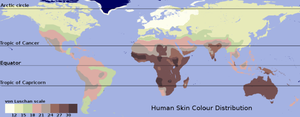Evolution of Skin Colours
Interview with
Some people are white, some people are black, some people are in-between. But where did all that originate and how do we end up with all the races that we have on Earth today? Joining Chris Smith to shed some light on this is Professor Nina Jablonski who is an anthropologist at Penn State University.
 Nina Jablonski - Hi Chris! It's great to be with you.
Nina Jablonski - Hi Chris! It's great to be with you.
Chris Smith - It's good to have you with us. So - tell us - actually why do we have different skin colours? What's the point of it?
Nina Jablonski - Different skin colours are due to different levels of the pigment melanin in the skin, and people at the equator or close to the equator tend to have a lot of melanin in their skin and people distributed farther away from the equator have considerably less.
Chris Smith - But what do we know if we look back in history, about how that came about? Because obviously we know people who live in my part of the world where we hardly see the sun one week in ten, compared with people in Africa where it's very sunny. What do we know about how those two systems of people evolved?
Nina Jablonski - The earliest members of our species evolved in equatorial Africa and had high levels of melanin pigment in their skin which protected them from the very deleterious harmful effects of ultraviolet radiation in the sun; which is present at great concentrations close to the equator. But as people in our species dispersed over the course of the last 50,000 years we dispersed into areas that had much lower levels of ultraviolet radiation, necessitating a loss of skin pigmentation. So you and your ancestors living in Britain are actually depigmented people compared to original members of our species.

Chris Smith - But why do we need dark skin - what actually is the pigment protecting us from? What is the sun doing? Because obviously we've all heard of skin cancer and the fact that there is this association between sun exposure and skin cancer; but is that the whole story?
Nina Jablonski - Not at all. Melanin pigment is tremendously good at absorbing and scattering ultraviolet-A radiation--long wavelength ultraviolet radiation, that destroys folate. Folate is a B-vitamin that is critical for the production of DNA; and DNA, as you know, is essential for new cells, for dividing cells, and so melanin protects against destruction of the cell division mechanism. So this is very, very important because it allows for instance early embryos to continue to undergo rapid cell division in a very precise way, lots of cell proliferation is going on and that is essential to survival. So melanin protects your cell division mechanism.
Chris Smith - But as I move away from Africa and go to climes like Britain where we have much less sun exposure, what's the point of going white? Why don't I just stay dark, because then I won't break down my folate and I won't get skin cancer?
Nina Jablonski - The reason that your ancestors underwent loss of pigmentation is that you still need to make vitamin-D in your skin. Your skin not only protects you from a lot of stuff but it's a vitamin factory, it makes vitamin-D. As you get farther north, the farther away from the equator, up where you are living, you get about two months during the year when you have ultraviolet-B radiation in the atmosphere that can cause vitamin-D production, you'd need to lose as much pigment as possible to take advantage of that very rare UVB; and that's why you and your ancestors look the way you do.
Chris Smith - So that explains what the benefit to me of living at the latitudes I do, of being white is, but what about if we wind the clock right back about six million years or so to the ancestor that precedes both humans and our closest living relatives, chimpanzees -
Nina Jablonski - Yes!

Chris Smith - What colour would that ancestor have been?
Nina Jablonski - Almost certainly we can be assured that that ancestor would have probably looked a lot more like chimpanzees than us. The ancestor would have had lightly pigmented skin covered with dark hair. When you look at all higher primates including chimpanzees, the rest of the apes and Old World monkeys, all of our closest cousins--this is the pattern that we see, light skin covered by dark hair; and what's interesting is that all of these animals have the ability to develop a tan on the exposed parts of their skin. For instance, on their faces, and on their hands, so that that ancestor probably would have had the same ability to develop a tan on the exposed areas.
Chris Smith - It's intriguing to think that we were white, went black, and that some of us have gone white again. Why did we lose our hair though? Why didn't we just keep the hair if that worked well for that ancestor, and stay white?
Nina Jablonski - Well, hair is a wonderful thing to protect and insulate us, but also it impedes our ability to lose heat when we're exercising vigorously. One of the things that primates do to keep cool is to sweat, and if you sweat a lot into a very hairy coat, you can't keep as cool as if you sweat onto a naked surface; and so we think now that we lost our hair in order to become better sweaters and to lose more of our body heat through evaporative cooling from sweating. So basically our ancestors probably lost their heavy coat of body hair, probably around two million years or so ago, and at the same time as we did that we increased the number of sweat glands, the output of the sweat glands, so that we are really prodigious sweaters compared to all other mammals, and we also at the same time gained our dark pigment in the skin. All of these things occurred more or less simultaneously.
Chris Smith - There have been some times when I've been standing on the bus next to someone I wished hadn't gained the ability to sweat. But talking of hair, what about the stereotypical Afro-Caribbean hair. What is the benefit of having hair like that? There must be one of having very short compact, but very curly hair--very dense curly hair like that? What's the evolutionary benefit of having that?
Nina Jablonski - Well we have not done the number of experimental studies that we would like to, but certainly we can look at other animals who have similar configured coverings of their skin and what we see is that this curly covering of hair, or feathers in some vertebrates, actually protects the skin from excessive heat, and it does it by this mechanism. The very external surface of the hair becomes very hot when you're under the sun, but that external surface then leaves a cooler barrier layer of air between the surface of the scalp or the skin, and the very surface that's being heated by the sun; and that cooler barrier layer is critical because it allows the scalp or the skin to lose heat by radiant heat loss as well as by sweating. So basically, this curly, frizzy hair keeps a lot of loft in it even when it's moist, and thereby maintains this barrier layer that keeps our heads cool.
Chris Smith - Which is good news if you live in Africa. But if you are a member of say the Indian Subcontinent where it's equally hot, but you have straight hair, how does that sit with that?
Nina Jablonski - Well, actually as long as there is some kind of barrier layer, it still will work, although not quite as well; and what's really interesting is that there are some people in the southern part of the Indian Subcontinent as well as in Melanesia who have curly dark hair that was probably evolved independently from the ancestral condition of curly dark hair.









Comments
Add a comment